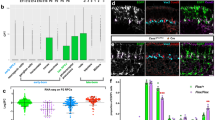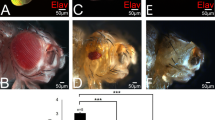Abstract
Organogenesis in vertebrates requires the tight control of cell proliferation and differentiation. The homeobox-containing transcription factor Six3 plays a pivotal role1,2 in the proliferation of retinal precursor cells. In a yeast two-hybrid screen, we identified the DNA replication-inhibitor geminin as a partner of Six3. Geminin inhibits cell-cycle progression3 by sequestering Cdt1 (refs 4, 5), the key component for the assembly of the pre-replication complex6. Here, we show that Six3 efficiently competes with Cdt1 directly to bind to geminin, which reveals how Six3 can promote cell proliferation without transcription. In common with Six3 inactivation2,7, overexpression of the geminin gene (Gem; also known as Gmn) in medaka (Oryzias latipes) induces specific forebrain and eye defects that are rescued by Six3. Conversely, loss of Gem (in common with gain of Six3 (ref. 1)) promotes retinal precursor-cell proliferation and results in expanded optic vesicles, markedly potentiating Six3 gain-of-function phenotypes. Our data indicate that the transcription factor Six3 and the replication-initiation inhibitor geminin act antagonistically to control the balance between proliferation and differentiation during early vertebrate eye development.
This is a preview of subscription content, access via your institution
Access options
Subscribe to this journal
Receive 51 print issues and online access
$199.00 per year
only $3.90 per issue
Buy this article
- Purchase on Springer Link
- Instant access to full article PDF
Prices may be subject to local taxes which are calculated during checkout




Similar content being viewed by others
References
Loosli, F., Winkler, S. & Wittbrodt, J. Six3 overexpression initiates the formation of ectopic retina. Genes Dev. 13, 649–654 (1999)
Carl, M., Loosli, F. & Wittbrodt, J. Six3 inactivation reveals its essential role for the formation and patterning of the vertebrate eye. Development 129, 4057–4063 (2002)
McGarry, T. J. & Kirschner, M. W. Geminin, an inhibitor of DNA replication, is degraded during mitosis. Cell 93, 1043–1053 (1998)
Wohlschlegel, J. A. et al. Inhibition of eukaryotic DNA replication by geminin binding to Cdt1. Science 290, 2309–2312 (2000)
Tada, S., Li, A., Maiorano, D., Mechali, M. & Blow, J. J. Repression of origin assembly in metaphase depends on inhibition of RLF-B/Cdt1 by geminin. Nature Cell Biol. 3, 107–113 (2001)
Maiorano, D., Moreau, J. & Mechali, M. XCDT1 is required for the assembly of pre-replicative complexes in Xenopus laevis. Nature 404, 622–625 (2000)
Lagutin, O. V. et al. Six3 repression of Wnt signaling in the anterior neuroectoderm is essential for vertebrate forebrain development. Genes Dev. 17, 368–379 (2003)
Tessmar, K., Loosli, F. & Wittbrodt, J. A screen for co-factors of Six3. Mech. Dev. 117, 103–113 (2002)
Loosli, F., Köster, R. W., Carl, M., Krone, A. & Wittbrodt, J. Six3, a medaka homologue of the Drosophila homeobox gene sine oculis is expressed in the anterior embryonic shield and the developing eye. Mech. Dev. 74, 159–164 (1998)
Treisman, J., Harris, E., Wilson, D. & Desplan, C. The homeodomain: a new face for the helix-turn-helix? Bioessays 14, 145–150 (1992)
Zhu, C. C. et al. Six3-mediated auto repression and eye development requires its interaction with members of the Groucho-related family of co-repressors. Development 129, 2835–2849 (2002)
Goudreau, G. et al. Mutually regulated expression of Pax6 and Six3 and its implications for the Pax6 haploinsufficient lens phenotype. Proc. Natl Acad. Sci. USA 99, 8719–8724 (2002)
Sawai, S. & Campos-Ortega, J. A. A zebrafish Id homologue and its pattern of expression during embryogenesis. Mech. Dev. 65, 175–185 (1997)
Winkler, S., Loosli, F., Henrich, T., Wakamatsu, Y. & Wittbrodt, J. The conditional medaka mutation eyeless uncouples patterning and morphogenesis of the eye. Development 127, 1911–1919 (2000)
Liang, J., Moye-Rowley, S. & Maurer, R. A. In vivo mutational analysis of the DNA binding domain of the tissue-specific transcription factor, Pit-1. J. Biol. Chem. 270, 25520–24425 (1995)
Sato, S. et al. Identification of transcriptional targets for Six5: implication for the pathogenesis of myotonic dystrophy type 1. Hum. Mol. Genet. 11, 1045–1058 (2002)
Zuber, M. E., Perron, M., Philpott, A., Bang, A. & Harris, W. A. Giant eyes in Xenopus laevis by overexpression of XOptx2. Cell 98, 341–352 (1999)
Nasevicius, A. & Ekker, S. C. Effective targeted gene ‘knockdown’ in zebrafish. Nature Genet. 26, 216–220 (2000)
Quinn, L. M., Herr, A., McGarry, T. J. & Richardson, H. The Drosophila Geminin homolog: roles for Geminin in limiting DNA replication, in anaphase and in neurogenesis. Genes Dev. 15, 2741–2754 (2001)
Toy, J., Yang, J.-M., Leppert, G. & Sundin, O. H. The Optx2 homeobox gene is expressed in early precursors of the eye and activates retina-specific genes. Proc. Natl Acad. Sci. USA 95, 10643–10648 (1998)
Seimiya, M. & Gehring, W. J. The Drosophila homeobox gene optix is capable of inducing ectopic eyes by an eyeless-independent mechanism. Development 127, 1879–1886 (2000)
Luo, L., Yang, X., Takihara, Y., Knoetgen, H. & Kessel, M. The cell-cycle regulator geminin inhibits Hox function through direct and polycomb-mediated interactions. Nature 427, 749–753 (2004)
Kroll, K. L., Salic, A. N., Evans, L. M. & Kirschner, M. W. Geminin, a neuralizing molecule that demarcates the future neural plate at the onset of gastrulation. Development 125, 3247–3258 (1998)
Köster, R., Stick, R., Loosli, F. & Wittbrodt, J. Medaka spalt acts as a target gene of hedgehog signaling. Development 124, 3147–3156 (1997)
Iwamatsu, T. Stages of normal development in the medaka Oryzias latipes. Zoo. Sci. 11, 825–839 (1994)
Acknowledgements
We acknowledge F. Loosli and J. Martinez for their critical input and discussion; P. Bovolenta and J. Lopez-Rios for the human Six3 construct and antibody; Z. Lygerou, T. Nishimoto, A. Mansouri, A. Nebreda and M. Mechali for providing plasmids and cells; and A. Akhtar and V. Neubrand for methodological advice. We thank C. Grabher, M. Rembold and W. Norton for critically reading the manuscript, E. Grzebisz for fish husbandry and A. Krone for technical assistance. We would like to thank M. Kessel for communicating unpublished results and for critical input. This work was supported by grants from the Deutsche Forschungsgemeinschaft, Collaborative Research Centre 488, the EU and HFSPO to J.W.
Author information
Authors and Affiliations
Corresponding author
Ethics declarations
Competing interests
The authors declare that they have no competing financial interests.
Supplementary information
Supplementary Figure 1
Subcellular localization. (JPG 30 kb)
Supplementary Figure 2
Mapping of the interacting domains of Geminin. (JPG 29 kb)
Supplementary Figure 3
Luciferase assay indicates inhibitory effect of Geminin on Six3 transcriptional activity. (JPG 23 kb)
Supplementary Figure 4
Geminin overxpression results in reduction of anterior neural marker expression. (JPG 75 kb)
Supplementary Figure 5
a) Antisense morpholino oligonucleotide blocks translation of medaka Geminin; b) addition of MoGFP, MoMiss or MoGem at 0.1mM to in vitro transcription/translation system reactions; c) Western Blot analysis of gemUTR-GFP expression in injected embryos. (JPG 45 kb)
Supplementary Figure 6
Geminin depletion and Six3 overexpression synergize in inducing retinal hyperplasia. (JPG 28 kb)
Supplementary Table 1
Concentration dependent effect upon injection of geminin mRNA and phenotypic rescue after coinjection with Six3 or Six3W216R mRNAs. (DOC 23 kb)
Supplementary Table 2
Morpholino injection experiments. (DOC 32 kb)
Rights and permissions
About this article
Cite this article
Bene, F., Tessmar-Raible, K. & Wittbrodt, J. Direct interaction of geminin and Six3 in eye development. Nature 427, 745–749 (2004). https://doi.org/10.1038/nature02292
Received:
Accepted:
Issue Date:
DOI: https://doi.org/10.1038/nature02292
This article is cited by
-
Whole-genome resequencing of three Coilia nasus population reveals genetic variations in genes related to immune, vision, migration, and osmoregulation
BMC Genomics (2021)
-
Developmental constraint through negative pleiotropy in the zygomatic arch
EvoDevo (2018)
-
Controlling centriole numbers: Geminin family members as master regulators of centriole amplification and multiciliogenesis
Chromosoma (2018)
-
Six3 regulates optic nerve development via multiple mechanisms
Scientific Reports (2016)
-
Gene regulatory networks in neural cell fate acquisition from genome-wide chromatin association of Geminin and Zic1
Scientific Reports (2016)
Comments
By submitting a comment you agree to abide by our Terms and Community Guidelines. If you find something abusive or that does not comply with our terms or guidelines please flag it as inappropriate.



